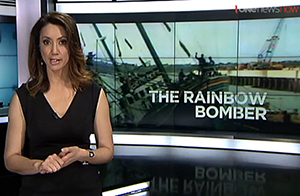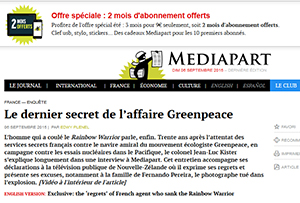
PARIS (France24/TVNZ Sunday/Mediapart/Pacific Media Watch): The French secret service frogman who attached the mines which sank the Greenpeace flagship Rainbow Warrior in New Zealand 30 years ago has apologised for his actions in an interview with the investigative website Mediapart.
Retired colonel Jean-Luc Kister, whose face was not covered in the hour-long video interview, said he believed it was now the right time to say sorry to the family of Portuguese-born Dutch photographer Fernando Pereira, who was killed in the explosion, to Greenpeace and to the people of New Zealand.
"Thirty years after the event, now that emotions have subsided and also with the distance I now have from my professional life, I thought it was the right time for me to express both my deepest regret and my apologies," Kister said.
 He also told TVNZ's Sunday programme in an interview broadcast last night that the operation was a "a big, big failure" and it had weighed on his conscience ever since.
He also told TVNZ's Sunday programme in an interview broadcast last night that the operation was a "a big, big failure" and it had weighed on his conscience ever since.
"For us it was just like using boxing gloves in order to crush a mosquito. It was a disproportionate operation, but we had to obey the order, we were soldiers," he said.
"Many times I think about these things because, for me, I have an innocent death on my hands."
Kister, who admitted being in many secret operations after the Rainbow Warrior bombing, now lives in Metz in northern France.
On July 10, 1985, the Rainbow Warrior was docked in Auckland on its way to protest against French nuclear testing at Moruroa Atoll, about 1200 km southeast of Tahiti.
Kister was working for France's spy agency, the DGSE, which carried out an unprecedented mission to stop Greenpeace by bombing a peaceful protest ship without warning in the waters of a friendly nation.
He was part of the so-called "third team", whose mission was to attach two large limpet mines to the hull of the converted trawler, working with fellow frogman Jean Camas.
A third member of the team, Gerard Royal, a brother of France's current Environment Minister and former presidential candidate Segolene Royal, picked up the two men after the covert operation.
"I have the blood of an innocent man on my conscience, and that weighs on me," a visibly emotional Kister said in the Mediapart interview. "We are not cold-blooded killers. My conscience led me to apologise and explain myself."
He said the mission that the 12-strong unit were ordered to carry out by then French Defence Minister Charles Hernu was "disproportionate" and he claimed that other less drastic ways of damaging the ship, such as breaking the propeller shaft to prevent it from taking to sea, were rejected by the government.
In the Sunday programme, he also admitted that newly independent Vanuatu, where the Rainbow Warrior visited prior to New Zealand, was considered as a location option for the bombing but was rejected as too risky.
"There was a willingness at a high level to say: this has to end once and for all, we need to take radical measures. We were told we had to sink it. Well, it's simple to sink a boat, you have to put a hole in it."
Name was leaked
Kister's name was leaked to the media soon after the bombing, albeit with a spelling mistake as Kyster. He said he considered his unmasking to be an act of "high treason".
"I'm not angry at the journalists, it's the political powers I blame. If it had been in the United States, other heads would have rolled."
Two days after the bombing, two of the agents who took part -- then colonel Alain Mafart and captain Dominique Prieur, who had posed as a couple of Swiss tourists -- were arrested by New Zealand police and their identities revealed. Hernu, the defence minister, was forced to resign two months later.
Mafart and Prieur were charged with murder, eventually pleading guilty to manslaughter and receiving 10-year jail terms, but they were freed within months for a three-year "house arrest" stint on Hao Atoll military base in French Polynesia under a deal that sparked almost as much anger in New Zealand as the bombing, involving France threatening to block trade access to European markets unless Wellington handed over the agents.
France has since made an official apology for the bombing of the Rainbow Warrior and paid damages. In 1996 it halted the nuclear testing that had prompted the Greenpeace protest.
In 1996 it halted the nuclear testing that had prompted the Greenpeace protest.
The interview was carried out by French journalist and Mediapart founder Edwy Plenel, who in September 1985 revealed in a Le Monde newspaper report the involvement of the DGSE frogman in planting the explosives.
Plenel says one aspect of the infamous bombing remains unexplained to this day -- how much then President François Mitterrand knew about the operation.
Although Mitterrand was aware that it was going to take place, "at which point did he know the operation was going to be so violent?", Plenel asked.
Full Mediapart video interview and investigation (in French)
This work is licensed under a Creative Commons Attribution-NonCommercial 3.0 New Zealand Licence.




